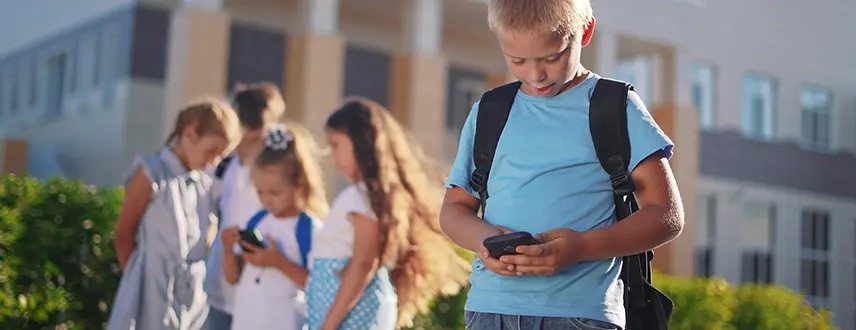The Impact of Mobile Phones on Education
 By
Jonathan Owen
By
Jonathan Owen Marketing Manager
Published
2nd October 2023
Last modified 31st July 2024
Last modified 31st July 2024
loveit? shareit!

Mobile phones in schools have long been a topic of debate among educators, parents, and students. The discussion often revolves around whether these devices are valuable learning tools or disruptive distractions. However, a deeper examination reveals that the impact of mobile phones on education extends beyond test scores and grades.
In a digital age, where adolescents are grappling with mental health challenges, the presence of smartphones in schools raises pertinent questions. Recent studies indicate that 1 in 7 adolescents in the UK between the ages of 11 and 16 has a diagnosable mental health disorder. At the same time, the majority of these adolescents own smartphones and actively engage with social media platforms.
A research study funded by the National Institute for Health Research at the University of Birmingham is delving into the intricate relationship between mobile phone usage and students’ mental wellbeing. This study aims to compare schools that restrict phone use with those that permit it during breaks and lunchtimes.
The key consideration here is how these technologies are employed. Smartphones and social media can potentially enhance mental wellbeing when used thoughtfully. Thus, the study seeks to pinpoint which school phone policies best support pupils’ mental health.
The motivation behind many of these policies is to limit distractions in the classroom. From a school’s perspective, implementing a mobile phone ban can be seen as a low-cost intervention with a potentially favourable benefit-cost ratio. The objective is clear: to improve student learning. However, from a parent’s viewpoint, the equation changes. The convenience of being able to contact their child often outweighs any potential benefits derived from the ban.
Over the past few decades, large urban school districts have experimented with mobile phone bans intermittently. However, most of these bans have been repealed due to their unpopularity with parents and students, along with concerns over equity. It’s worth noting that many low-income students rely solely on mobile devices for internet access.
A significant shift occurred in March 2015 when the New York City Department of Education (NYCDOE) lifted its longstanding district-wide mobile phone ban, granting schools substantial discretion in designing and implementing policies governing student mobile phone use.
While most research focuses on the impact of mobile phone use on test scores, reaction time, and the ability to focus, there’s another layer to consider. This research introduces two vital dimensions: discipline and the school culture.
Discipline plays a critical role in schools. A mobile phone ban, if violated, could lead to punitive measures, such as suspensions. These consequences can have a negative impact on a student’s learning experience, even when weighed against the potential benefits of the ban.
Additionally, school culture is a critical factor in educational productivity and student wellbeing. Schools should not solely concentrate on academic achievement; they must also consider other elements that contribute to the overall learning environment.
The research findings offer valuable insights. Following the removal of the NYCDOE’s mobile phone ban, there were positive impacts on school discipline. However, this change came at a cost to the school culture. Student perception of respect, behavior, and safety declined. Teacher perception of school safety also suffered. While there was an improvement in educational productivity due to the ban’s removal, it came with a tradeoff, affecting the school culture negatively.
In 2018, we delved into the intriguing question, “Do Smartphones Steal Childhoods?” This thought-provoking blog explored the effects of smartphone usage on the younger generation, sparking conversations about the potential impact on childhood experiences. If you’re interested in diving deeper into the complex relationship between technology and childhood, be sure to check out our earlier exploration. It provides valuable insights that complement the ongoing debate surrounding mobile phones in schools.

When discussing safety, it’s crucial to distinguish between emergency situations and day-to-day school life. While students may feel safer having access to a phone during emergencies, the routine use of phones within school can create safety challenges. Issues such as bullying, harassment, and inappropriate use of social media can be exacerbated when mobile phones are present in the school environment.
Moving forward, policymakers must grapple with the complexities of mobile phones in schools. The research indicates that while there are benefits to removing bans, there are also significant tradeoffs, particularly related to school culture and safety.
Balancing the distractions and benefits of mobile phones in the classroom is crucial. Some schools are experimenting with innovative solutions, such as magnetized pouches that allow students to access their phones under specific circumstances, such as during class activities or lunch.
In a recent announcement, Education Secretary Gillian Keegan has reignited the debate on mobile phone usage in schools. The government is set to release new guidance urging head teachers in England to implement stringent rules, banning students from using mobile phones throughout the entire school day, including breaks.
This move by the Department for Education comes as a response to concerns about the increasing distraction posed by mobile phones in classrooms. Ms. Keegan, in her address at the Conservative Party conference, emphasized that mobile phones are often used as a source of distraction and, regrettably, as tools for bullying.
However, this is not the first time such a proposal has been put forward. Schools have, over the years, grappled with the issue of mobile phones in the classroom. Many already have bans or restrictions in place, with head teachers given the autonomy to define their schools’ mobile phone policies.
In fact, former Education Secretary Gavin Williamson expressed support for a ban in 2021, stating that “mobile phones should not be used or seen during the school day.” Nevertheless, in February 2022, the education department concluded that blanket national rules were not necessary, as the majority of schools in England had already taken action.
While the government argues that expanding these guidelines will lead to a reduction in phone usage during school hours, critics, including teachers’ unions, have raised concerns. Geoff Barton, the general secretary of the Association of School and College Leaders, pointed out that most schools already had policies in place to manage mobile phone usage effectively.
Dr. Patrick Roach, the general secretary of NASUWT, expressed skepticism about the effectiveness of a blanket ban, suggesting that it could exacerbate behavioral challenges rather than resolve them.
The issue of mobile phone usage in schools is not unique to England. France and China have implemented national bans on phones in schools, and the Netherlands is set to follow suit in 2024.
As the government pushes for stricter mobile phone regulations, schools continue to grapple with a complex issue. The challenge lies in finding a balanced approach that addresses both the potential distractions of mobile phones and the concerns about students’ ability to communicate with their parents in emergencies.
The debate surrounding mobile phones in schools is multifaceted, and the impact of these policies on student behavior, academic achievement, and school culture remains a topic of ongoing discussion. Balancing the benefits and drawbacks of mobile phone usage in the classroom remains a challenge, one that schools, parents, and policymakers must navigate carefully.